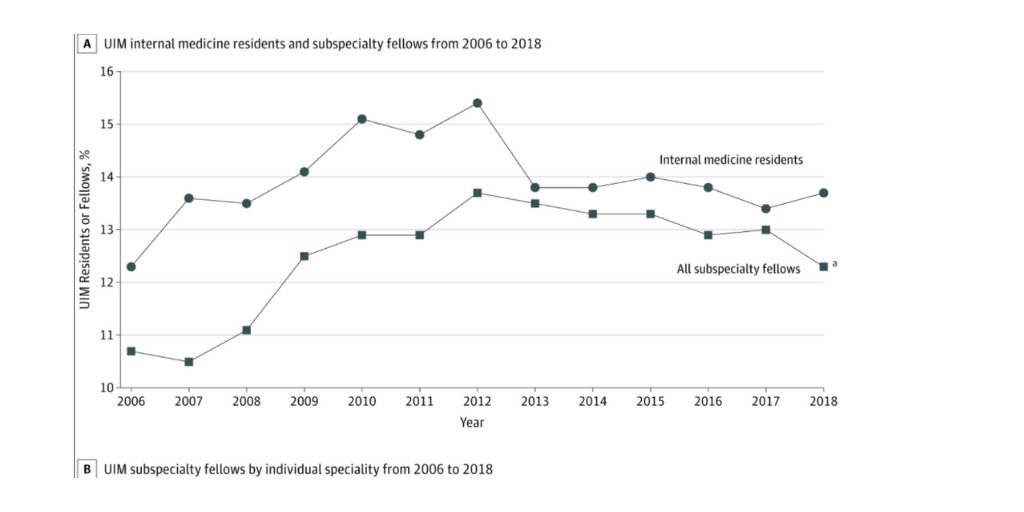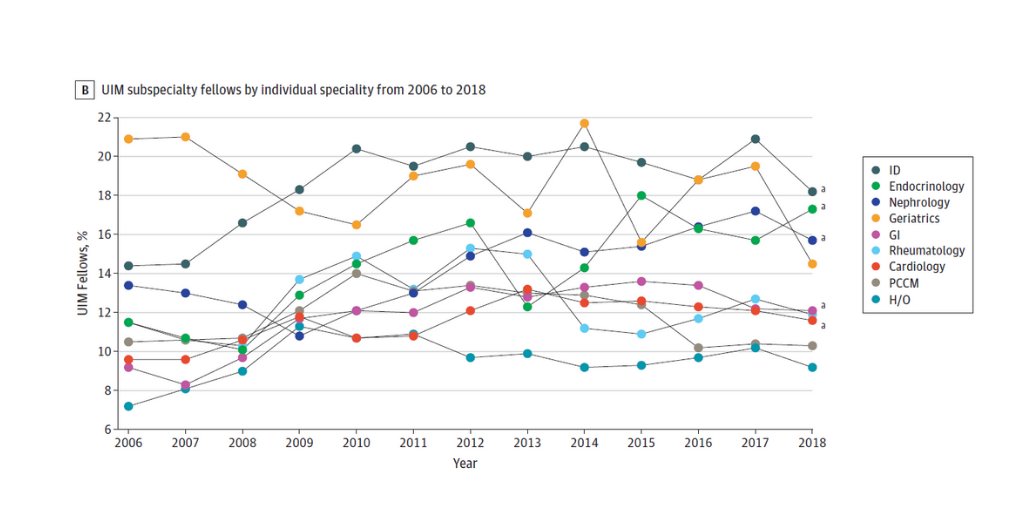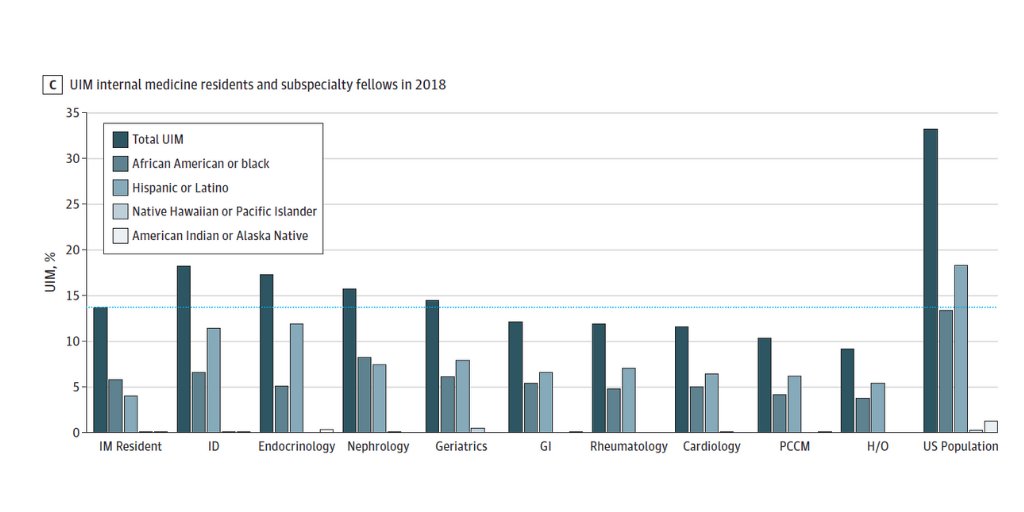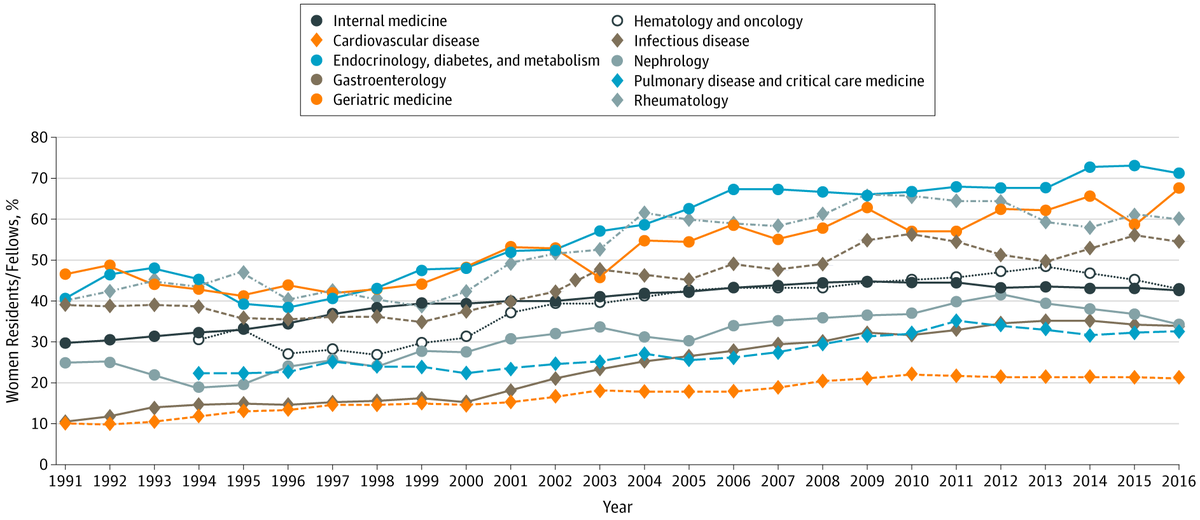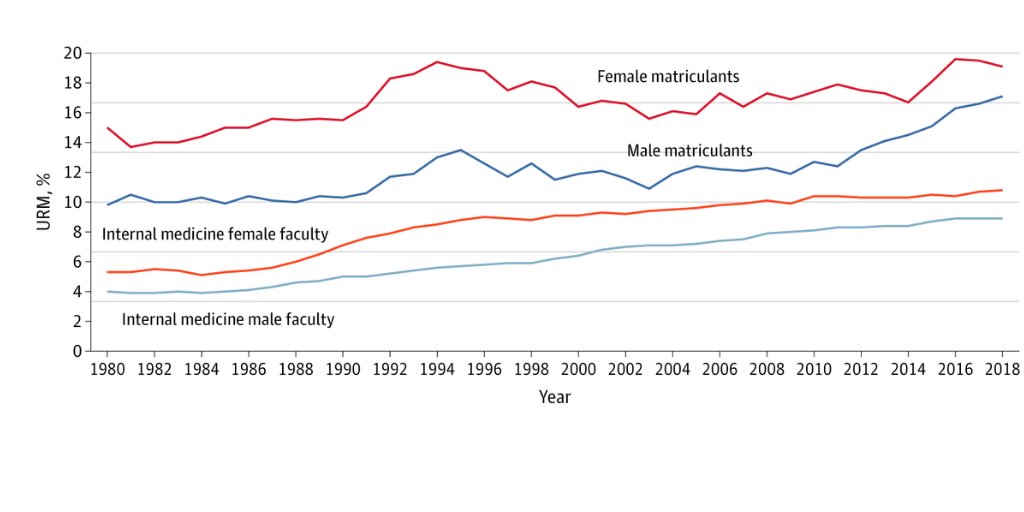1/ In our recent @JAMANetworkOpen article, we compare diversity of Internal Medicine workforce to that of a rapidly diversifying US population & med student body. CC: senior author @GoldenSherita.
In this thread, I will discuss context & lingering gaps https://jamanetwork.com/journals/jamanetworkopen/fullarticle/2770061">https://jamanetwork.com/journals/...
In this thread, I will discuss context & lingering gaps https://jamanetwork.com/journals/jamanetworkopen/fullarticle/2770061">https://jamanetwork.com/journals/...
2/
In our paper, we found that between 1980 & 2018, the % of underrepresented in medicine (URM) IM faculty https://abs.twimg.com/emoji/v2/... draggable="false" alt="⬆️" title="Pfeil nach oben" aria-label="Emoji: Pfeil nach oben">
https://abs.twimg.com/emoji/v2/... draggable="false" alt="⬆️" title="Pfeil nach oben" aria-label="Emoji: Pfeil nach oben"> https://abs.twimg.com/emoji/v2/... draggable="false" alt="⬆️" title="Pfeil nach oben" aria-label="Emoji: Pfeil nach oben"> (from 4.1% to 9.7%), as did the % of URM matriculants ( 11.3% to 18.1%).
https://abs.twimg.com/emoji/v2/... draggable="false" alt="⬆️" title="Pfeil nach oben" aria-label="Emoji: Pfeil nach oben"> (from 4.1% to 9.7%), as did the % of URM matriculants ( 11.3% to 18.1%).
However, these gains were still not reflective of US population.
In our paper, we found that between 1980 & 2018, the % of underrepresented in medicine (URM) IM faculty
However, these gains were still not reflective of US population.
3/
We also found the % of women IM faculty https://abs.twimg.com/emoji/v2/... draggable="false" alt="⬆️" title="Pfeil nach oben" aria-label="Emoji: Pfeil nach oben">steadily but still remained lower than their representation in the US population.
https://abs.twimg.com/emoji/v2/... draggable="false" alt="⬆️" title="Pfeil nach oben" aria-label="Emoji: Pfeil nach oben">steadily but still remained lower than their representation in the US population.
In contrast female medical student representation https://abs.twimg.com/emoji/v2/... draggable="false" alt="⬆️" title="Pfeil nach oben" aria-label="Emoji: Pfeil nach oben">
https://abs.twimg.com/emoji/v2/... draggable="false" alt="⬆️" title="Pfeil nach oben" aria-label="Emoji: Pfeil nach oben"> https://abs.twimg.com/emoji/v2/... draggable="false" alt="⬆️" title="Pfeil nach oben" aria-label="Emoji: Pfeil nach oben"> substantially & their proportion actually surpassed the proportion of females in US population.
https://abs.twimg.com/emoji/v2/... draggable="false" alt="⬆️" title="Pfeil nach oben" aria-label="Emoji: Pfeil nach oben"> substantially & their proportion actually surpassed the proportion of females in US population.
We also found the % of women IM faculty
In contrast female medical student representation
4/
A notable missing piece of our analysis= IM residents/ IM specialty fellows.
We discuss this briefly in our paper, but worth shouting out the work that was recently done in this space.
A notable missing piece of our analysis= IM residents/ IM specialty fellows.
We discuss this briefly in our paper, but worth shouting out the work that was recently done in this space.
5/
Earlier this year @LekshmiMD @jen_babik published “Racial and Ethnic Diversity in Internal Medicine Subspecialty Fellowships, 2006 to 2018 also in @JAMANetworkOpen @JAMANetwork https://ja.ma/3351lMD ">https://ja.ma/3351lMD&q...
Earlier this year @LekshmiMD @jen_babik published “Racial and Ethnic Diversity in Internal Medicine Subspecialty Fellowships, 2006 to 2018 also in @JAMANetworkOpen @JAMANetwork https://ja.ma/3351lMD ">https://ja.ma/3351lMD&q...
6/ The authors found a few things:
1. Over time, the percentage of Underreprented in Medicine (UIM) trainees was unchanged in IM residencies (12.3% vs. 13.7%; P = .28) but increased in all subspecialty fellowships (10.7% vs 12.3% P < .001)
1. Over time, the percentage of Underreprented in Medicine (UIM) trainees was unchanged in IM residencies (12.3% vs. 13.7%; P = .28) but increased in all subspecialty fellowships (10.7% vs 12.3% P < .001)
7/
2. The percentage of UIM fellows was unchanged in geriatrics, heme/onc, pulm/crit, & rheum.
But increased in cardiology, endocrine, GI, nephro, & infectious disease.
( ID had the highest percentage of UIM fellows overtime, heme/onc had the lowest)
2. The percentage of UIM fellows was unchanged in geriatrics, heme/onc, pulm/crit, & rheum.
But increased in cardiology, endocrine, GI, nephro, & infectious disease.
( ID had the highest percentage of UIM fellows overtime, heme/onc had the lowest)
8/
3. "More than half had lower percentages of UIM trainees than IM residencies—a useful benchmark, given that residents are the direct pipeline for subspecialty fellows.”
& 4. similar to our article: “In 2018, no specialties reflected the diversity of the US population."
3. "More than half had lower percentages of UIM trainees than IM residencies—a useful benchmark, given that residents are the direct pipeline for subspecialty fellows.”
& 4. similar to our article: “In 2018, no specialties reflected the diversity of the US population."
9/ Anna Stone, @pamelasdouglas et. al added to the discussion in a @JAMANetwork @JAMAInternalMed piece "Subspecialty Choices of Men and Women in Internal Medicine From 1991 to 2016 https://ja.ma/335QRwi ">https://ja.ma/335QRwi&q...
10/
They found that between 1991 and 2016, although the percentage of women in internal medicine residencies increased (30.2%-->40.3%), the percentage of women in [any] subspecialty fellowships decreased (33.3%--->23.6).
They found that between 1991 and 2016, although the percentage of women in internal medicine residencies increased (30.2%-->40.3%), the percentage of women in [any] subspecialty fellowships decreased (33.3%--->23.6).
11/
For the 9 subspecialties of IM that they evaluated, the percentage of women entering each of the fields increased over time, w/ variations between specialty. Endocrin, rheum, & geriatrics have experienced the highest rates of increase in the percentages of women fellows.
For the 9 subspecialties of IM that they evaluated, the percentage of women entering each of the fields increased over time, w/ variations between specialty. Endocrin, rheum, & geriatrics have experienced the highest rates of increase in the percentages of women fellows.
12/
With the addition of these two articles, we have a fuller understanding of the race, ethnicity, and sex trends across the pipeline from med student-->IM resident/fellow---> IM Faculty.
With the addition of these two articles, we have a fuller understanding of the race, ethnicity, and sex trends across the pipeline from med student-->IM resident/fellow---> IM Faculty.
13/
In our paper, we also evaluate the intersection of sex/race & ethnicity & found that URM+Female has grown at faster rates & have higher proportions than URM+Males for both med students & IM faculty.
In our paper, we also evaluate the intersection of sex/race & ethnicity & found that URM+Female has grown at faster rates & have higher proportions than URM+Males for both med students & IM faculty.
14/
While we did not have the data in this report, we postulate based on reports like "Altering the course, Black men in Medicine" that lack of growth in representation of Black men in medicine may contribute. to the lowerr representation among URM+males https://store.aamc.org/altering-the-course-black-males-in-medicine.html">https://store.aamc.org/altering-...
While we did not have the data in this report, we postulate based on reports like "Altering the course, Black men in Medicine" that lack of growth in representation of Black men in medicine may contribute. to the lowerr representation among URM+males https://store.aamc.org/altering-the-course-black-males-in-medicine.html">https://store.aamc.org/altering-...
15/
These types of intersectional analyses are important, but we also mention that one major limitation of our work was the inability to account for gender identity. This has implications.
These types of intersectional analyses are important, but we also mention that one major limitation of our work was the inability to account for gender identity. This has implications.
16/
As @TanmoyDasLala @AAMCtoday recently reported, "less than 1% of U.S. medical students &physicians self-identify as transgender or gender nonbinary, yet the population of TGNB individuals is growing exponentially." https://www.aamc.org/news-insights/we-need-more-transgender-and-gender-nonbinary-doctors">https://www.aamc.org/news-insi...
As @TanmoyDasLala @AAMCtoday recently reported, "less than 1% of U.S. medical students &physicians self-identify as transgender or gender nonbinary, yet the population of TGNB individuals is growing exponentially." https://www.aamc.org/news-insights/we-need-more-transgender-and-gender-nonbinary-doctors">https://www.aamc.org/news-insi...
17/Identity does not always fit neatly into boxes. As we think about workforce diversity, perhaps what is most important, is that our research questions, data collection, recruitment & retention strategies etc. are granular & attentive enough to capture what falls outside the box
No matter the specialty, we must continue to work to ensure that people can bring their full selves to the discipline of medicine AND that they can be encouraged/celebrated for doing so. This is a starting for inclusion to be more than just a word that stands beside diversity.END

 Read on Twitter
Read on Twitter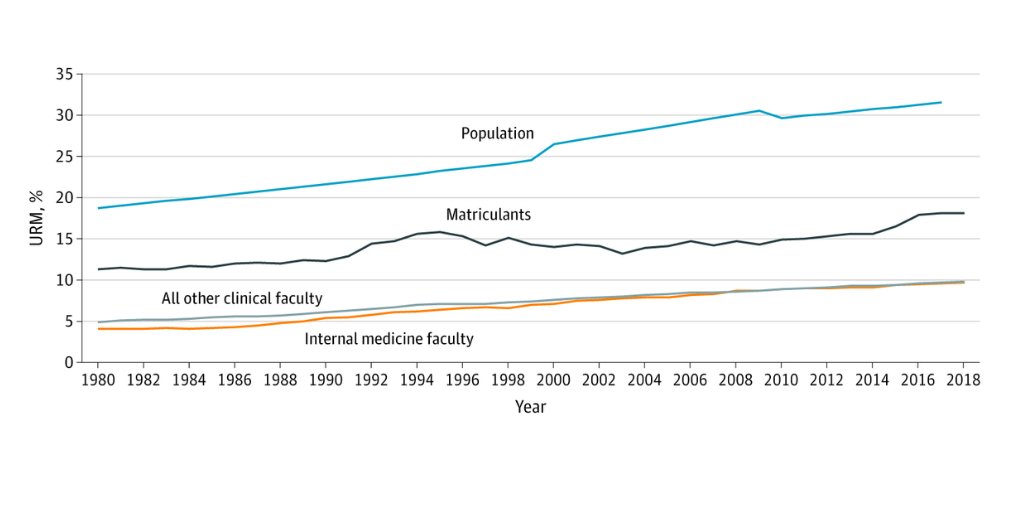 https://abs.twimg.com/emoji/v2/... draggable="false" alt="⬆️" title="Pfeil nach oben" aria-label="Emoji: Pfeil nach oben"> (from 4.1% to 9.7%), as did the % of URM matriculants ( 11.3% to 18.1%). However, these gains were still not reflective of US population." title="2/ In our paper, we found that between 1980 & 2018, the % of underrepresented in medicine (URM) IM faculty https://abs.twimg.com/emoji/v2/... draggable="false" alt="⬆️" title="Pfeil nach oben" aria-label="Emoji: Pfeil nach oben">https://abs.twimg.com/emoji/v2/... draggable="false" alt="⬆️" title="Pfeil nach oben" aria-label="Emoji: Pfeil nach oben"> (from 4.1% to 9.7%), as did the % of URM matriculants ( 11.3% to 18.1%). However, these gains were still not reflective of US population." class="img-responsive" style="max-width:100%;"/>
https://abs.twimg.com/emoji/v2/... draggable="false" alt="⬆️" title="Pfeil nach oben" aria-label="Emoji: Pfeil nach oben"> (from 4.1% to 9.7%), as did the % of URM matriculants ( 11.3% to 18.1%). However, these gains were still not reflective of US population." title="2/ In our paper, we found that between 1980 & 2018, the % of underrepresented in medicine (URM) IM faculty https://abs.twimg.com/emoji/v2/... draggable="false" alt="⬆️" title="Pfeil nach oben" aria-label="Emoji: Pfeil nach oben">https://abs.twimg.com/emoji/v2/... draggable="false" alt="⬆️" title="Pfeil nach oben" aria-label="Emoji: Pfeil nach oben"> (from 4.1% to 9.7%), as did the % of URM matriculants ( 11.3% to 18.1%). However, these gains were still not reflective of US population." class="img-responsive" style="max-width:100%;"/>
 steadily but still remained lower than their representation in the US population.In contrast female medical student representation https://abs.twimg.com/emoji/v2/... draggable="false" alt="⬆️" title="Pfeil nach oben" aria-label="Emoji: Pfeil nach oben">https://abs.twimg.com/emoji/v2/... draggable="false" alt="⬆️" title="Pfeil nach oben" aria-label="Emoji: Pfeil nach oben"> substantially & their proportion actually surpassed the proportion of females in US population." title="3/ We also found the % of women IM faculty https://abs.twimg.com/emoji/v2/... draggable="false" alt="⬆️" title="Pfeil nach oben" aria-label="Emoji: Pfeil nach oben">steadily but still remained lower than their representation in the US population.In contrast female medical student representation https://abs.twimg.com/emoji/v2/... draggable="false" alt="⬆️" title="Pfeil nach oben" aria-label="Emoji: Pfeil nach oben">https://abs.twimg.com/emoji/v2/... draggable="false" alt="⬆️" title="Pfeil nach oben" aria-label="Emoji: Pfeil nach oben"> substantially & their proportion actually surpassed the proportion of females in US population." class="img-responsive" style="max-width:100%;"/>
steadily but still remained lower than their representation in the US population.In contrast female medical student representation https://abs.twimg.com/emoji/v2/... draggable="false" alt="⬆️" title="Pfeil nach oben" aria-label="Emoji: Pfeil nach oben">https://abs.twimg.com/emoji/v2/... draggable="false" alt="⬆️" title="Pfeil nach oben" aria-label="Emoji: Pfeil nach oben"> substantially & their proportion actually surpassed the proportion of females in US population." title="3/ We also found the % of women IM faculty https://abs.twimg.com/emoji/v2/... draggable="false" alt="⬆️" title="Pfeil nach oben" aria-label="Emoji: Pfeil nach oben">steadily but still remained lower than their representation in the US population.In contrast female medical student representation https://abs.twimg.com/emoji/v2/... draggable="false" alt="⬆️" title="Pfeil nach oben" aria-label="Emoji: Pfeil nach oben">https://abs.twimg.com/emoji/v2/... draggable="false" alt="⬆️" title="Pfeil nach oben" aria-label="Emoji: Pfeil nach oben"> substantially & their proportion actually surpassed the proportion of females in US population." class="img-responsive" style="max-width:100%;"/>
